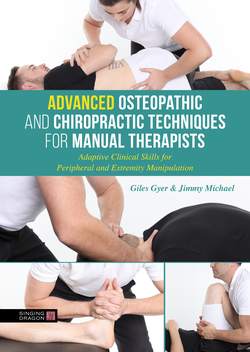Читать книгу Advanced Osteopathic and Chiropractic Techniques for Manual Therapists - Giles Gyer - Страница 10
На сайте Литреса книга снята с продажи.
Modulation of alpha motor neuron activity
ОглавлениеThe involvement of alpha motor neurons in the modulation of musculoskeletal pain has been proposed by two of the prominent theories of pain: (1) the pain–spasm–pain cycle (Cooperstein, Young and Haneline 2013) and (2) the pain-adaptation model (Lund et al. 1991). The pain–spasm–pain model proposes two distinct neural pathways that contribute to pain. However, both theories have one common basis: that hyperexcitability of the alpha motor neuron pool leads to increased muscle activity. One neural pathway is described above (see ‘Modulation of gamma motor neuron activity’). Another pathway involves the projections of nociceptors onto alpha motor neurons via excitatory interneurons. On the other hand, the pain-adaptation model postulates that pain increases muscle activity when the muscle acts as antagonist and decreases it when active as agonist. The neural pathway proposed for this model involves feedback of nociceptive afferents projecting onto alpha motor neurons via both excitatory and inhibitory interneurons. The central nervous system (CNS) is thought to control the function of these interneurons and provide motor command of whether to excite or inhibit the alpha motor neuron pool (van Dieën et al. 2003). In short, regardless of the exact neural pathways, it may be said that the alpha motor neuron excitability forms the basis in the mechanism of musculoskeletal pain, as the modulation of alpha motor neurons correlates with changes in muscle activation.
Spinal manipulation has been thought to relax or normalise hypertonic muscle through modulating alpha motor neuron activity. However, the exact effect(s) of manipulation on motor neurons is still unknown. As described above (see ‘Muscle activation’), most of the higher-quality EMG studies conducted to date demonstrated a significant attenuation of muscle activity following manipulation during forward bend or lying prone position (Lehman 2012). In a recent study on LBP patients, after observing reductions in EMG muscle activity during the flexion-relaxation phase, Bicalho et al. (2010) suggested that such decreases in EMG amplitude might be due to two different scenarios: (1) the hyperexcitability of the alpha motor neuron pool was decreased following spinal manipulation, or (2) manipulation increased the inhibition of the alpha motor unit. Nevertheless, the clinical relevance of EMG amplitude changes on the motor neuron pool is unclear, as EMG muscle activity changes were found to be transient in nature, and several studies have reported conflicting results.
Two experimental techniques that have been used to effectively measure motor neuron activity after mechanical stimulation include the H-reflex and transcranial magnetic stimulation (TMS). The H-reflex technique assesses the spinal reflex pathways that project onto the target muscle, bypassing the muscle spindle. It reveals an estimate of changes to the alpha motor neuron excitability following spinal manipulation (Burke 2016). In contrast, the TMS technique uses changing magnetic fields to measure the corticospinal tract excitability between the motor cortex and targeted muscle, evoking motor-evoked potential (MEP). It reveals the alterations in the motor cortex excitability after manipulation (Klomjai, Katz and Lackmy-Vallée 2015).
A series of studies conducted by Dishman and colleagues (Dishman and Bulbulian 2000, 2001; Dishman and Burke 2003; Dishman, Cunningham and Burke 2002; Dishman, Dougherty and Burke 2005) has consistently reported a significant but temporary attenuation of alpha motor neuron excitability after spinal manipulation using H-reflexes. One major shortcoming of these studies was that they lacked a no intervention control group. These findings, however, were contrasted by Suter, McMorland and Herzog (2005) who, after observing no alteration in H-reflexes in a subgroup, argued that the decreases in the H-reflex could be due to movement artifact during manipulation. In contrast, with a randomised controlled crossover design, Fryer and Pearce (2012) supported the findings of Dishman and colleagues but opposed Suter et al.’s (2005) conclusion. They reported that inhibition of H-reflexes was not associated with movement artifact as the control group showed no significant changes undergoing the same repositioning of the intervention group. More recently, in a cross-sectional study that included both asymptomatic healthy volunteers and subacute LBP patients, Dishman, Burke and Dougherty (2018) reported suppression of the Ia afferent-alpha motor neuron pathway and a valid and reliable attenuation of the Hmax/Mmax ratio1 following spinal manipulation, which was beyond movement or position artifacts. This finding presents a completely meaningful physiological difference and provides convincing evidence in support of the long-held notion that HVLAT manipulation inhibits the excitability of the alpha motor neuron pool.
Since 2000, changes in MEPs following spinal manipulation have been examined by only a few researchers, and they reported conflicting results. While Dishman et al. (Dishman, Ball and Burke 2002; Dishman, Greco and Burke 2008) reported a transient but significant increase in MEPs compared with baseline after manipulation, Clark et al. (2011) found a slight decrease but no significant alteration in the erector spinae MEP amplitude. In contrast, Fryer and Pearce (2012) observed a significant reduction in MEP amplitudes following manipulation. However, it is to be noted that Fryer and Pearce followed an established protocol to measure MEPs and recorded amplitudes roughly 10 minutes after the intervention, and thus speculated that a transient facilitation of MEPs might have occurred at the beginning. On the other hand, Dishman et al. observed that changes in MEPs returned to baseline 30–60 seconds following manipulation. Nevertheless, such conflicting data do not evidently indicate that spinal manipulation alters the corticospinal tract excitability.
Taken together, although spinal manipulation has been reported to result in a significant decrease in H-reflexes and EMG amplitudes, the clinical relevance of such short-lived changes on the motor neuron pool in the mechanisms that underlie the effectiveness of spinal manipulation is still speculative and needs to be determined.
